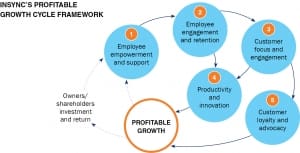2016/17 Higher Cap determinations, community engagement and trade-offs
The much anticipated Essential Services Commission (ESC) determination on the 2016-17 Higher Cap applications is now out.
Benchmarking board performance: 500 board reviews later
Unlock evidence-based insights into board performanceBy Nicholas Barnett, CEO, Insync
Cash flow is the lifeblood of business. Without it they die. We can’t achieve cash inflow over a sustained period unless businesses are profitable. This is why most businesses and investors are so focussed on the level of profitability and trends relating to it. Profitability also impacts the enterprise’s value, which is of high interest to business owners.
But profit is an outcome. It’s actually a by-product of getting lots of other things right. Past profitability indicates future profitability but what are the other important predictors of success and can they be easily measured? Can tomorrow’s profit be measured today? I believe that the wise place to start, in terms of understanding future profitability, is to understand employee engagement levels. I hold this this view despite starting my career as an accountant 35 years ago.
Profitability is important but most won’t pursue profits no matter the cost. Not many SMEs would cut employees and/or customers to make a short term gain, as capacity to make future profits would be compromised. So how important are employees and customers in the quest for greater profits? Who comes first? At Insync we measure and improve employee and customer engagement. We find that these are fundamental questions not only for CEOs but also for business owners and other executives. Their collective view will impact the way strategy and key decisions are developed and implemented.
In my experience most business owners think that customers come first and employees second. This is a real concern as that view leads to poor implementation of strategy and poor decision-making. Understanding who comes first is an important topic for business owners, their CEOs and executives to debate to ensure they all get on the same page.
Research we conducted involving over 1,000 employee and customer surveys shows that organisations that achieve profitable growth start by investing in their employees. Providing employees with clear direction and expectations and also empowering them to do their jobs well, leads to greater employee engagement and retention.
Insync’s Profitable Growth Cycle, as it’s known, continues with engaged employees leading to stronger customer relationships, which creates greater customer loyalty and advocacy. Add to the mix an increase in productivity and innovation based on input from both engaged employees and engaged customers and you start creating a virtuous cycle of profitable growth as shown in the following diagram, Insync’s Profitable Growth Cycle:


As business leaders we can help other executives understand that their employees won’t look after the SME’s customers until the SME looks after its employees.
Understanding and buying into this framework for driving profitable growth will impact the way plans and decisions are made and the measures that businesses will need to collect and monitor. Some of those important measures will include employee turnover, employee engagement (measured by an employee engagement survey), customer trust, customer commitment, purchase intentions and customer promoter scores (these things can be measured by customer satisfaction surveys).
In some further ground-breaking research conducted by Insync involving the views of over 100,000 employees from around 200 organisations, 7 habits that most differentiate high performing organisations from low performing organisations were revealed. That research forms the basis of my book “The 7 business habits“.
The 7 business habits are:
These habits confirm the importance of engaging your employees in an authentic way and then listening and adapting to your customers’ needs to build sustainable high performance. Businesses need to go somewhere – it is incumbent on CEOs to set out a compelling long-term direction, strategy and clear goals for their business too.
This article first appeared in Inside Small Business, February 2015
Shape your culture well – it will then shape you
From stereotypical sceptic to passionate diversity campaigner
The much anticipated Essential Services Commission (ESC) determination on the 2016-17 Higher Cap applications is now out.
There has been a massive recalibration of expectations of all boards and senior executives (not just in Financial Services) in relation to how organisations
As humans we have many unconscious biases and in organisations our leadership decisions are also subject to them. Gender bias leads to predetermined views of talent, ...
Most organisations are challenged by new and increasing competition from low cost, internet-based business models that are commoditising many products and services. ...
We use cookies to enhance your experience. Further use is considered consent. You can read more about cookies in our Privacy Policy.


You’ll always get a real person when you contact Insync.
Let's get started